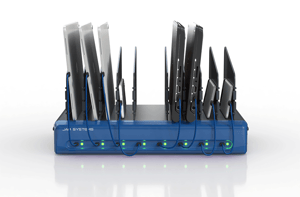As technology in the classroom has flourished, so has the number of platforms that teachers and students use to support learning.
While these platforms provide the classroom with exciting new opportunities and tools for learning and gathering data insights, they also cause a huge delay in learning. This is because within a single day, teachers often find themselves wasting time visiting dozens of platforms to access information on student performance, curricular resources, and tools for assessment. Similarly, students are required to access different tools based on the subject, or topic, they are learning about.
Fortunately, there is a solution that will help deliver accurate, actionable information to teachers and students in a timely way: data interoperability. So, what is data interoperability and why should your district embark on the journey towards it?
What is Data Interoperability? ![]()
I agree, it’s a mouthful. In simple terms, data interoperability is the ability for different systems to interact, understand each other, and exchange information. Applied to everyday life, interoperability allows you to send texts between devices that run different mobile operating systems. It lets you transfer money through an app without ever having to visit the bank and enables doctors to send your prescription to the pharmacy near instantly, with the tap of a button.
When put in the context of education, data interoperability allows teachers to pull resources from a single learning management system (LMS) that has pooled together tools from a number of platforms. It allows students to download and utilize applications designed to enrich their learning, then sync data across devices. It also manifests as a universal charging standard that is compatible across all Chromebook, notebook, tablet, or smartphone devices, making classroom charging easier than ever before. Put simply, data interoperability is the final piece of the puzzle when creating the big picture.
Why Seek Interoperability in Education?
As districts have increased their use of technology-based solutions, the need to build an interoperable environment has increased. Lagging behind other industries, schools are still having to endure time-consuming and manual processes when it comes to gathering and storing information.
Data is also being divided across different systems that cannot communicate, hindering the rate at which it can be located or transferred. This lack of integration also limits student progress because it requires educators to spend valuable time managing data – time which would be better spent on their students, or the lesson plan.
Interoperability helps streamline how data is exchanged and seeks to reduce or eliminate common IT delays, such as having to log onto and pull resources from individual platforms. This helps to create a more accurate, accessible, integrated, and efficient data infrastructure that teachers can rely on to help improve student outcomes.
The Benefits of Data Interoperability 
1. Better Access to Digital Content
Currently, educators are having to juggle various platforms for access to learning tools, assessments, and student performance data. This is because many of these platforms are standalone, meaning they store their data in unique formats (or "languages") that cannot be understood by other platforms. With data interoperability, the data format (or "language") will become a universal standard. This will allow a variety of platforms to communicate with others, making it faster and easier to locate, compile, and extract the digital information stored in each of them.
2. Improved Personalized Learning Initiatives
Personalized learning relies heavily on sharing information around student learning. When systems are able to communicate this information seamlessly, it becomes easier to measure student progress and adjust teaching methods accordingly.
3. Trackable Insights
There are many indicators of student progress. However, having to log-into and compare student performance data across multiple data platforms makes it hard to have a productive conversation. Being able to access accurate information in a single location will provide districts with a reliable measure to determine whether they are achieving their learning objectives. These insights are not only useful in monitoring student progress, but also in making decisions to improve student outcomes.
4. More Efficient IT Departments
Interoperability will save schools money by reducing many manual or repetitive tasks associated with managing multiple information databases. This will not only free up time for more meaningful projects, but also save the budget from being spent on time-consuming data management tasks.
5. Refined Vendor Practices
Districts are coming to recognize that, as EdTech purchasers, they have the power to demand that vendors and other content providers comply with basic data interoperability standards. These standards require that vendor platforms produce data that can, effectively, be automatically assembled into a single learning management system or portal. This means that instead of having to undergo the timely process of manually translating different “languages” of data from a range of platforms to a central location, all of the data will all already be accessible, available, and ready-to-use.
The Journey Towards Data Interoperability
Every minute counts in the classroom and right now, too much time is being spent on manual data management practices. Luckily, there is a solution: data interoperability.
When districts truly become interoperable, digital content and tools will be easily accessible from a single learning management system or portal. Within and between districts, information exchange will be effortless without requiring additional interventions. Instead of having to log-on to multiple databases, students will be able to access information with the click of a button.
This movement toward data interoperability provides districts with a way to leverage data to create better outcomes for students, save time for teachers and IT professionals, and improve budget efficiencies. Despite these benefits, however, the biggest barrier to implementing interoperability in education—aside from the word itself—is that it takes time. Further, many teachers are unaware that the issues they are currently facing are fixable. So, let's spread the word! The sooner we embark on this journey towards data interoperability, the better.
Conveniently Power and Charge Up to 8 USB-C Devices at Once 
JAR Systems has developed a charging dock capable of charging up to 8 USB-C devices simultaneously. This versatile solution is the first of its kind, and uses sophisticated charging technology that automatically senses and adjusts the power supply to suit the needs of Chromebooks, notebooks, tablets, and other mobile devices. Click below to learn more about the Universal USB-C Charging Dock and to reserve one today!
